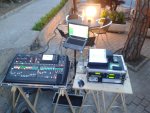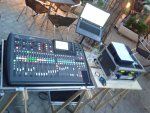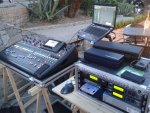X32 Discussion
- Thread starter Rob Spence
- Start date
You are using an out of date browser. It may not display this or other websites correctly.
You should upgrade or use an alternative browser.
You should upgrade or use an alternative browser.
Re: X32 Discussion
Yes, DCA's or digitally controlled amplifiers are the digital desk version of the VCA or voltage controlled amplifier. VCA's are basically a circuit that uses the output from the fader as a control voltage rather than directing the audio through the fader. This is good as if the fader is crackily it does not have an overly detrimental effect of the audio on that channel. The way a VCA is used in practice is to allow one fader to control multiple faders by using that one fader as a control voltage to adjust each of the assigned channels output levels, think remote control for those channels and you get the idea.Analog desks didn't have DCAs. That came with digital desks (I think). Analog desks had VCAs.
Sent from my iPad HD
Re: X32 Noisy Cooling Fan
Wireless in ear monitors, especially the oldest sennheiser ew do have problems when connected to a digital desk.
What do you mean by ears? We have headphones connected if that's what you mean.
Wireless in ear monitors, especially the oldest sennheiser ew do have problems when connected to a digital desk.
Re: X32 Noisy Cooling Fan
 Thanks, no we don't have any wireless in-ears. We do have a bunch of stuff plugged in as inputs and outputs, so it could be something else in the chain.
Thanks, no we don't have any wireless in-ears. We do have a bunch of stuff plugged in as inputs and outputs, so it could be something else in the chain.
For inputs, we have your regular SM58's and SM57's, a bunch of cheap drum mic's forget the brand, 2 Shure wireless mics' (one is is UHF, other is VHF), a audio technica wireless lapel, a few passive DI's for guitars, an ipod connected to the aux in 5/6. Also on the output side, we aux 5/6 going to a distributor which has a number of various devices connected to it, including PC's, amplifiers and FM transmitters. We actually have 13, 14, 15, 16 of our outputs for mains (it should be noted that 13/14 are the effects channels that we actually actively use). Sometimes we will have output 12 directly going into input 32 for monitoring purposes (I've disconnected that as well as 13/14 main outs to ensure that those aren't affecting things).
That's by memory, I think it is pretty complete. However, often when the issue happens, there is only one microphone active, one of the wireless shures (rest are muted), and noone is touching the XControl.
I will get a copy of the scene and post it here tomorrow (It happens in all our scenes as far as I know, I'll post our most basic scene that gets it frequently)
Wireless in ear monitors, especially the oldest sennheiser ew do have problems when connected to a digital desk.
For inputs, we have your regular SM58's and SM57's, a bunch of cheap drum mic's forget the brand, 2 Shure wireless mics' (one is is UHF, other is VHF), a audio technica wireless lapel, a few passive DI's for guitars, an ipod connected to the aux in 5/6. Also on the output side, we aux 5/6 going to a distributor which has a number of various devices connected to it, including PC's, amplifiers and FM transmitters. We actually have 13, 14, 15, 16 of our outputs for mains (it should be noted that 13/14 are the effects channels that we actually actively use). Sometimes we will have output 12 directly going into input 32 for monitoring purposes (I've disconnected that as well as 13/14 main outs to ensure that those aren't affecting things).
That's by memory, I think it is pretty complete. However, often when the issue happens, there is only one microphone active, one of the wireless shures (rest are muted), and noone is touching the XControl.
I will get a copy of the scene and post it here tomorrow (It happens in all our scenes as far as I know, I'll post our most basic scene that gets it frequently)
Re: X32 Noisy Cooling Fan
Hey Joseph, I'm curious exactly what your achieving by doing this? Can you please elaborate?
Sometimes we will have output 12 directly going into input 32 for monitoring purposes
Hey Joseph, I'm curious exactly what your achieving by doing this? Can you please elaborate?
Re: X32 Discussion
Spence is well acquainted with VCAs... he was around before they were invented... /nudge, wink...
Allen & Heath have a nice article about using VCAs (and now DCAs) in controlling and mixing. http://174.120.239.226/~ggclocac/allen_health.pdf
There are also a couple of threads and article about VCA/DCA use on the PSW site: mixing with dcas/vcas and Church Sound: Church Sound: Understanding Mixing Console VCAs And VCA Groups - Pro Sound Web
Yes, DCA's or digitally controlled amplifiers are the digital desk version of the VCA or voltage controlled amplifier. VCA's are basically a circuit that uses the output from the fader as a control voltage rather than directing the audio through the fader. This is good as if the fader is crackily it does not have an overly detrimental effect of the audio on that channel. The way a VCA is used in practice is to allow one fader to control multiple faders by using that one fader as a control voltage to adjust each of the assigned channels output levels, think remote control for those channels and you get the idea.
Spence is well acquainted with VCAs... he was around before they were invented... /nudge, wink...
Allen & Heath have a nice article about using VCAs (and now DCAs) in controlling and mixing. http://174.120.239.226/~ggclocac/allen_health.pdf
There are also a couple of threads and article about VCA/DCA use on the PSW site: mixing with dcas/vcas and Church Sound: Church Sound: Understanding Mixing Console VCAs And VCA Groups - Pro Sound Web
Re: X32 Noisy Cooling Fan
Please try to differentiate between mixbusses and outputs, because I can't believe you have analog output 12 routed via a xlr cable to input 32?
I think you mean that analog outputs 13,14,15,16 are routed / patched to mains LR, and that mixbus 13,14 is used for effect sends?
Also on the output side, we aux 5/6 going to a distributor which has a number of various devices connected to it, including PC's, amplifiers and FM transmitters. We actually have 13, 14, 15, 16 of our outputs for mains (it should be noted that 13/14 are the effects channels that we actually actively use). Sometimes we will have output 12 directly going into input 32 for monitoring purposes (I've disconnected that as well as 13/14 main outs to ensure that those aren't affecting things).
Please try to differentiate between mixbusses and outputs, because I can't believe you have analog output 12 routed via a xlr cable to input 32?
We actually have 13, 14, 15, 16 of our outputs for mains (it should be noted that 13/14 are the effects channels that we actually actively use).
I think you mean that analog outputs 13,14,15,16 are routed / patched to mains LR, and that mixbus 13,14 is used for effect sends?
Re: X32 Discussion
One confusing thing is that a channel strip can be vca controlled via its own fader.
This doesen't mean that there is a seperate group of faders controlling other channel strips but rather that the actual fader on a channel strip is constructed as a vca circuit.
One confusing thing is that a channel strip can be vca controlled via its own fader.
This doesen't mean that there is a seperate group of faders controlling other channel strips but rather that the actual fader on a channel strip is constructed as a vca circuit.
Re: X32 Discussion
Yes, common on DJ mixer crossfaders and on high end analog consoles as is allows for easier automation.One confusing thing is that a channel strip can be vca controlled via its own fader.
This doesen't mean that there is a seperate group of faders controlling other channel strips but rather that the actual fader on a channel strip is constructed as a vca circuit.
Re: X32 Discussion
...and if you want to get into Confusionland, the DCA's on a digital consoles are not DCAs at all, they are just variables that modifies a multiplier constant for the gain function at the point where it is inserted. At the fader position of a channel, you have possibly the eight DCA plus the main fader, nine variables that get multiplied to get the gain constant that is used to modify the data stream.
Let's say the Main fader is at +3dB, the first four DCA are at 0db and the final four at -3db, then the calculated constant will be 1.41x1.00x1.00x1.00x1.00x0.71x0.71x0.71x0.71=0.35355339. This constant is only calculated when something change, but is used 44100 or 48000 times pr. second as a multiplier to modify the data stream of that channel. Actually, having lots and lots of DCAs doesn't cost anything in terms of processing power, it is just a matter of housekeeping ~:-D~:grin:
~:-D~:grin:
One confusing thing is that a channel strip can be vca controlled via its own fader.
This doesen't mean that there is a seperate group of faders controlling other channel strips but rather that the actual fader on a channel strip is constructed as a vca circuit.
...and if you want to get into Confusionland, the DCA's on a digital consoles are not DCAs at all, they are just variables that modifies a multiplier constant for the gain function at the point where it is inserted. At the fader position of a channel, you have possibly the eight DCA plus the main fader, nine variables that get multiplied to get the gain constant that is used to modify the data stream.
Let's say the Main fader is at +3dB, the first four DCA are at 0db and the final four at -3db, then the calculated constant will be 1.41x1.00x1.00x1.00x1.00x0.71x0.71x0.71x0.71=0.35355339. This constant is only calculated when something change, but is used 44100 or 48000 times pr. second as a multiplier to modify the data stream of that channel. Actually, having lots and lots of DCAs doesn't cost anything in terms of processing power, it is just a matter of housekeeping
Re: X32 Discussion
I've done some experimenting and I really like the factory default for FX1, which I believe is "Vintage Room Reverb". I generally use that and the stereo delay (also default for FX3). I tend to use the default for FX2 (forget what the name is) for snare drums. Then I use FX4 as my wild card, depending on the act its a phaser, flanger, or something else I have yet to really mess with.
While I'm here I should mention, one of the things I like about the X32 over "other" digitals (ackhem presonus cough cough) is the effects. Way, way usable and musical sounding. Like something you'd get in a high end studio.
What efx are you guys using on the X32 for vocals?
I've done some experimenting and I really like the factory default for FX1, which I believe is "Vintage Room Reverb". I generally use that and the stereo delay (also default for FX3). I tend to use the default for FX2 (forget what the name is) for snare drums. Then I use FX4 as my wild card, depending on the act its a phaser, flanger, or something else I have yet to really mess with.
While I'm here I should mention, one of the things I like about the X32 over "other" digitals (ackhem presonus cough cough) is the effects. Way, way usable and musical sounding. Like something you'd get in a high end studio.
Re: X32 Discussion
Oh Per I love when you calculate constants. Every time I pass out and wake up in a cornfield.
the calculated constant will be 1.41x1.00x1.00x1.00x1.00x0.71x0.71x0.71x0.71=0.35355339.
Oh Per I love when you calculate constants. Every time I pass out and wake up in a cornfield.
Re: X32 Discussion
Are you with a little girl in a gingham dress, a tin man and a lion?
Oh Per I love when you calculate constants. Every time I pass out and wake up in a cornfield.
Are you with a little girl in a gingham dress, a tin man and a lion?
Firmware update in the pipeline?
Hi all,
I've not been able to keep tracks on all of the recent posts in this thread, but some time back there was discussion around firmware 2.0 and feature requests that being added.
It appears to have gone somewhat quiet on that front. Does anyone have any insight to progress with new firmware ?
Having some sort of "user" permissions/restrictions would benefit me in my church setting. Also, I'm keen to see a bug in XiControl Ipad app resolved.
Thanks,
Anthony
Hi all,
I've not been able to keep tracks on all of the recent posts in this thread, but some time back there was discussion around firmware 2.0 and feature requests that being added.
It appears to have gone somewhat quiet on that front. Does anyone have any insight to progress with new firmware ?
Having some sort of "user" permissions/restrictions would benefit me in my church setting. Also, I'm keen to see a bug in XiControl Ipad app resolved.
Thanks,
Anthony
Re: X32 Discussion
Which bug would that be?
Wasn't the waking up in a cornfield reference a more recent one?
Also, I'm keen to see a bug in XiControl Ipad app resolved.
Which bug would that be?
Are you with a little girl in a gingham dress, a tin man and a lion?
Wasn't the waking up in a cornfield reference a more recent one?
Re: X32 Discussion
Which bug would that be?
Hi Per, Please see my post #5662 on 6th April.
http://soundforums.net/junior-varsity/4393-x32-discussion-284.html#post53728
Anthony
Re: X32 Noisy Cooling Fan
If this is a terrible idea, let me know. We never put this analog in, back into the main mix again, that's scary, it's well labeled that it's just for monitor mixes.
Yes, this is probably where the confusion is coming from for me. See my monitors, are on mix bus 1-8, and I use the analog outputs for those, and on the X32, I press the 9-16 button and I see effects by default on 13-16 (mix bus), but I use analog outputs in that range for my mains. I take it the internal routing is not outputting to the analog outs for effects then, just an internal "effects send".
Thanks for the clarification Antoon, I'm still coming to grips with how the X32 works, I've spent a lot more time with more simpler analog boards, and just came off a long stint with a 01V, which did routing a bit different, and I probably didn't fully understand that one either lol.
I just woke up, but I'll post a scene file from our X32 in an hour or so.
Maybe there's a better way, but what the intention is, is having a single analog input that has the entire mix, post fader that the musicians can control with a single fader. This is important because, for some musicians, all they need is the general mix, and having to mix a bit of this or that is too cumbersome (as long as the sound guy is on the ball). It also makes managing the iphone app easier too. This also helps with our overall mix, as even having a little bit of the main mix going to the stage monitors, helps keep a consistant sound near stage. Some musicians also want to hear their effects as they're applied as well, so it helps with that too.Hey Joseph, I'm curious exactly what your achieving by doing this? Can you please elaborate?
If this is a terrible idea, let me know. We never put this analog in, back into the main mix again, that's scary, it's well labeled that it's just for monitor mixes.
Please try to differentiate between mixbusses and outputs, because I can't believe you have analog output 12 routed via a xlr cable to input 32?
I think you mean that analog outputs 13,14,15,16 are routed / patched to mains LR, and that mixbus 13,14 is used for effect sends?
Yes, this is probably where the confusion is coming from for me. See my monitors, are on mix bus 1-8, and I use the analog outputs for those, and on the X32, I press the 9-16 button and I see effects by default on 13-16 (mix bus), but I use analog outputs in that range for my mains. I take it the internal routing is not outputting to the analog outs for effects then, just an internal "effects send".
Thanks for the clarification Antoon, I'm still coming to grips with how the X32 works, I've spent a lot more time with more simpler analog boards, and just came off a long stint with a 01V, which did routing a bit different, and I probably didn't fully understand that one either lol.
I just woke up, but I'll post a scene file from our X32 in an hour or so.
Re: X32 Discussion
Yeah, but I'm in Kansas. We have to play the cards we're dealt....
Wasn't the waking up in a cornfield reference a more recent one?
Yeah, but I'm in Kansas. We have to play the cards we're dealt....
Re: X32 Noisy Cooling Fan
If you have mixbusses over, you better rout all the signals you rout to mains also to this bus, then you can INTERNAL rout this back to any input.
If you set mode of that mixbuss to subgroup, you don't have to set any volume.
Be sure you don't rout that input also to this same mixbus, or you get problems.
Not a way of work I would promote as long as you don't fully understand your console...
Maybe there's a better way, but what the intention is, is having a single analog input that has the entire mix, post fader that the musicians can control with a single fader.
If you have mixbusses over, you better rout all the signals you rout to mains also to this bus, then you can INTERNAL rout this back to any input.
If you set mode of that mixbuss to subgroup, you don't have to set any volume.
Be sure you don't rout that input also to this same mixbus, or you get problems.
Not a way of work I would promote as long as you don't fully understand your console...




